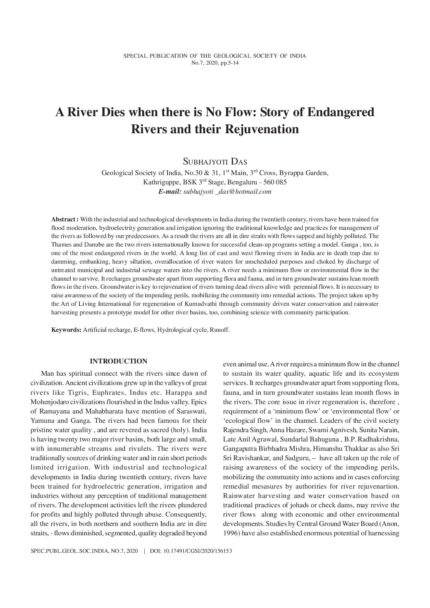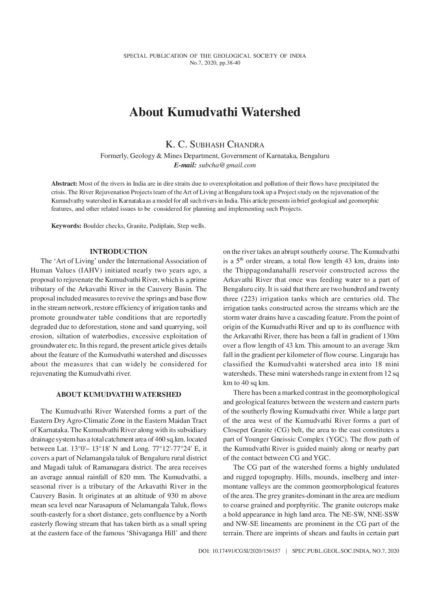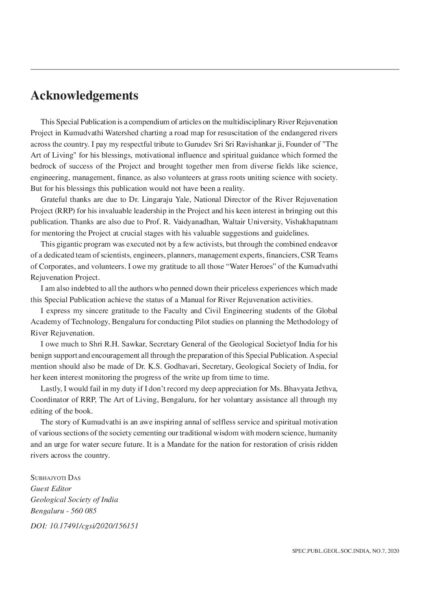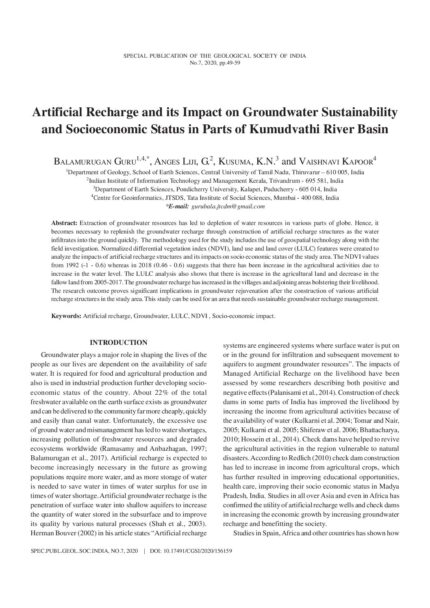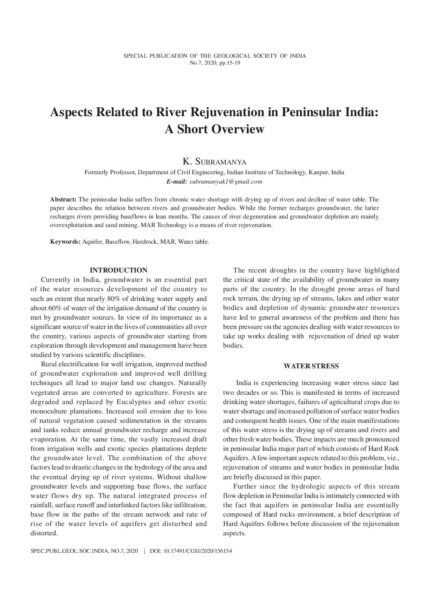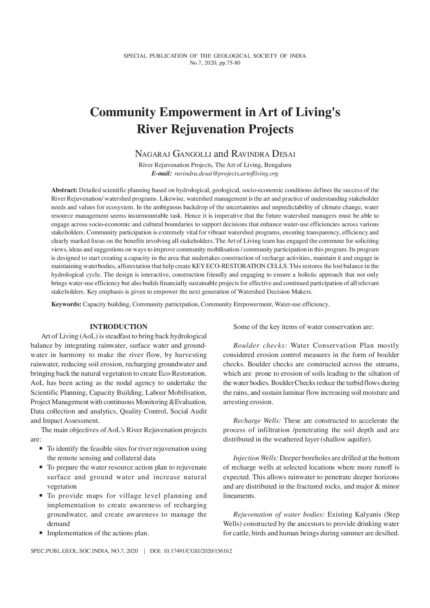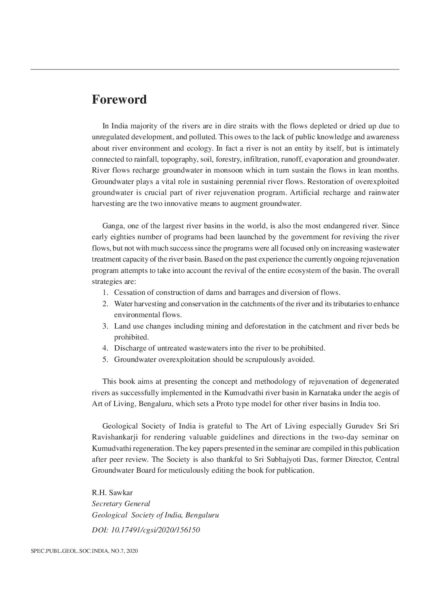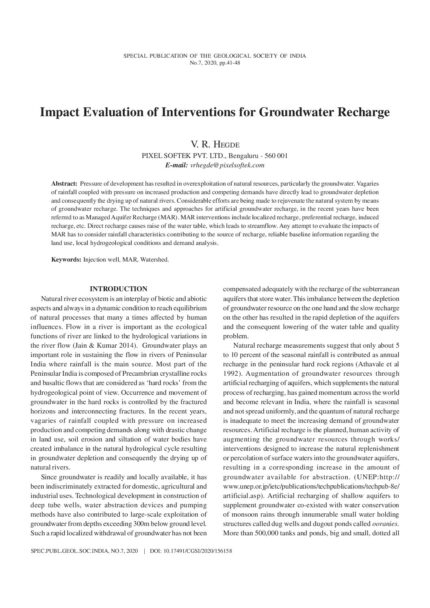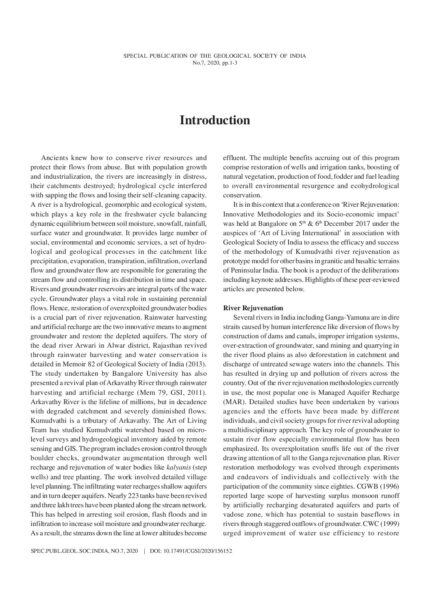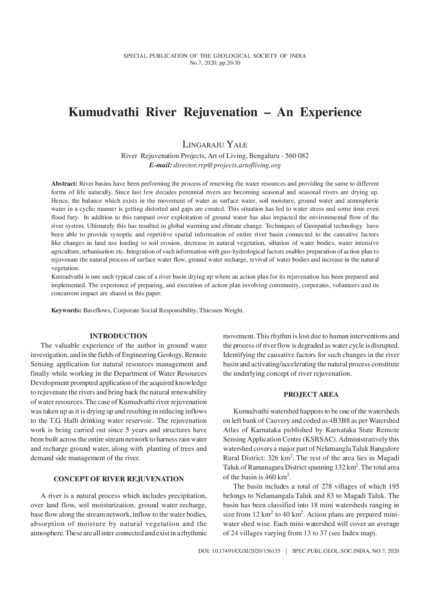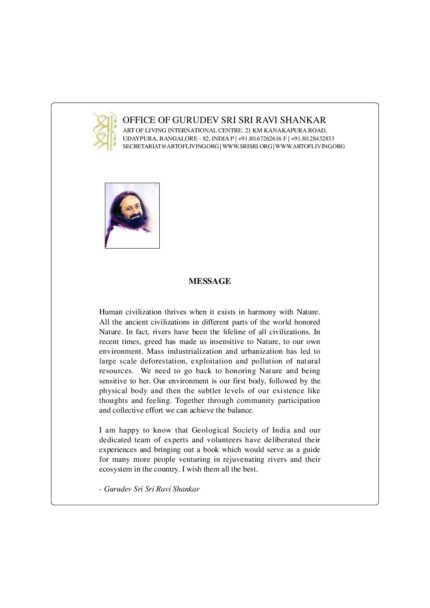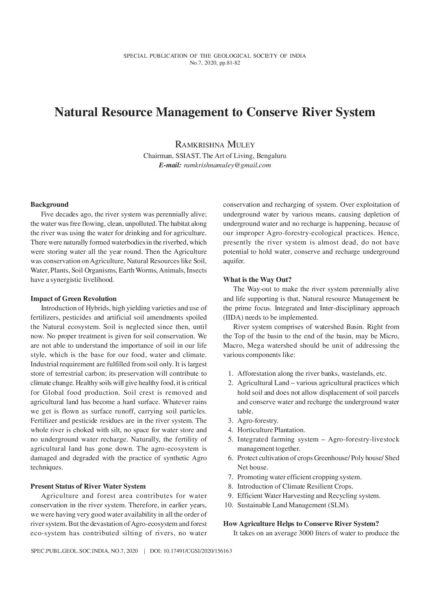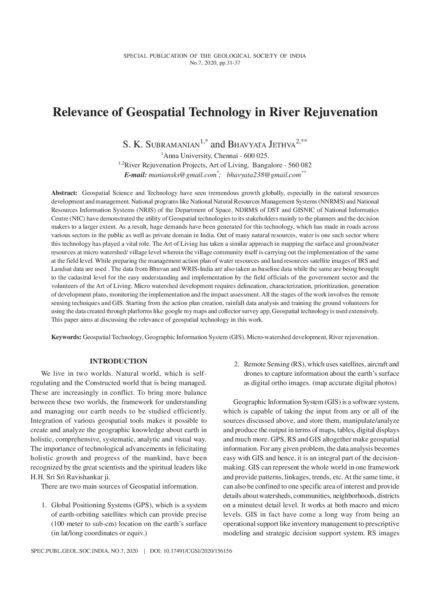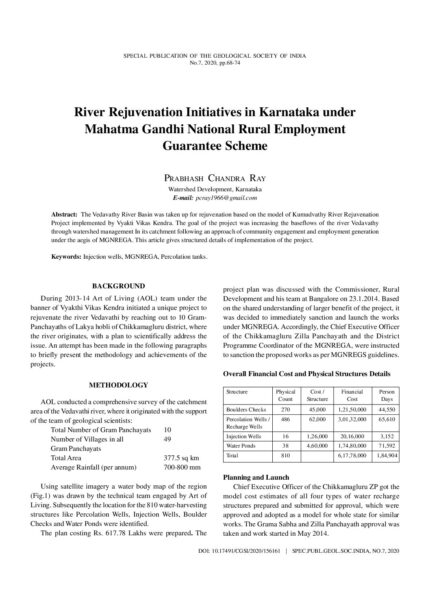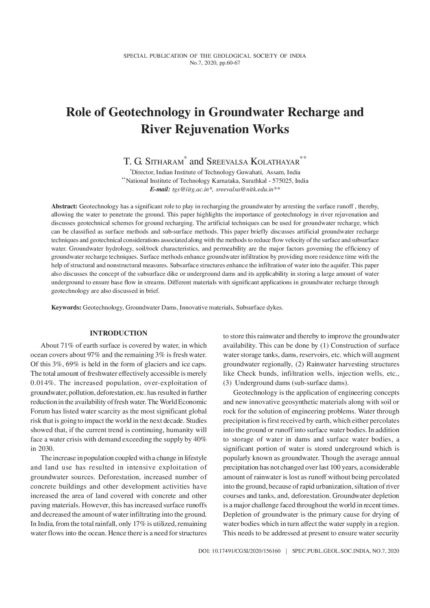SP-07:River Rejuvenation: Kumudvathi Model
A River Dies when there is No Flow: Story of Endangered Rivers and their Rejuvenation
SKU:
C-156153
With the industrial and technological developments in India during the twentieth century, rivers have been trained for flood moderation, hydroelectrity generation and irrigation ignoring the traditional knowledge and practices for management of the rivers as followed by our predecessors. As a result the rivers are all in dire straits with flows sapped and highly polluted. The Thames and Danube are the two rivers internationally known for successful clean-up programs setting a model. Ganga , too, is one of the most endangered rivers in the world. A long list of east and west flowing rivers in India are in death trap due to damming, embanking, heavy siltation, overallocation of river waters for unscheduled purposes and choked by discharge of untreated municipal and industrial sewage waters into the rivers. A river needs a minimum flow or environmental flow in the channel to survive. It recharges groundwater apart from supporting flora and fauna, and in turn groundwater sustains lean month flows in the rivers. Groundwater is key to rejuvenation of rivers turning dead rivers alive with perennial flows. It is necessary to raise awareness of the society of the impending perils, mobilizing the community into remedial actions. The project taken up by the Art of Living International for regeneration of Kumudvathi through community driven water conservation and rainwater harvesting presents a prototype model for other river basins, too, combining science with community participation.
Artificial Recharge and its Impact on Groundwater Sustainability and Socioeconomic Status in Parts of Kumudvathi River Basin
SKU:
C-156159
Extraction of groundwater resources has led to depletion of water resources in various parts of globe. Hence, it becomes necessary to replenish the groundwater recharge through construction of artificial recharge structures as the water infiltrates into the ground quickly. The methodology used for the study includes the use of geospatial technology along with the field investigation. Normalized differential vegetation index (NDVI), land use and land cover (LULC) features were created to analyze the impacts of artificial recharge structures and its impacts on socio economic status of the study area. The NDVI values from 1992 (-1 - 0.6) whereas in 2018 (0.46 - 0.6) suggests that there has been increase in the agricultural activities due to increase in the water level. The LULC analysis also shows that there is increase in the agricultural land and decrease in the fallow land from 2005-2017. The groundwater recharge has increased in the villages and adjoining areas bolstering their livelihood. The research outcome proves significant implications in groundwater rejuvenation after the construction of various artificial recharge structures in the study area. This study can be used for an area that needs sustainable groundwater recharge management.
Aspects Related to River Rejuvenation in Peninsular India: A Short Overview
SKU:
C-156154
The peninsular India suffers from chronic water shortage with drying up of rivers and decline of water table. The paper describes the relation between rivers and groundwater bodies. While the former recharges groundwater, the latter recharges rivers providing baseflows in lean months. The causes of river degeneration and groundwater depletion are mainly overexploitation and sand mining. MAR Technology is a means of river rejuvenation.
Community Empowerment in Art of Living’s River Rejuvenation Projects
SKU:
C-156162
Detailed scientific planning based on hydrological, geological, socio-economic conditions defines the success of the River Rejuvenation/ watershed programs. Likewise, watershed management is the art and practice of understanding stakeholder needs and values for ecosystem. In the ambiguous backdrop of the uncertainties and unpredictability of climate change, water resource management seems insurmountable task. Hence it is imperative that the future watershed managers must be able to engage across socio-economic and cultural boundaries to support decisions that enhance water-use efficiencies across various stakeholders. Community participation is extremely vital for vibrant watershed programs, ensuring transparency, efficiency and clearly marked focus on the benefits involving all stakeholders. The Art of Living team has engaged the commune for soliciting views, ideas and suggestions on ways to improve community mobilisation / community participation in this program. Its program is designed to start creating a capacity in the area that undertakes construction of recharge activities, maintain it and engage in maintaining waterbodies, afforestation that help create KEY ECO-RESTORATION CELLS. This restores the lost balance in the hydrological cycle. The design is interactive, construction friendly and engaging to ensure a holistic approach that not only brings water-use efficiency but also builds financially sustainable projects for effective and continued participation of all relevant stakeholders. Key emphasis is given to empower the next generation of Watershed Decision Makers.
Impact Evaluation of Interventions for Groundwater Recharge
SKU:
C-156158
Pressure of development has resulted in overexploitation of natural resources, particularly the groundwater. Vagaries of rainfall coupled with pressure on increased production and competing demands have directly lead to groundwater depletion and consequently the drying up of natural rivers. Considerable efforts are being made to rejuvenate the natural system by means of groundwater recharge. The techniques and approaches for artificial groundwater recharge, in the recent years have been referred to as Managed Aquifer Recharge (MAR). MAR interventions include localized recharge, preferential recharge, induced recharge, etc. Direct recharge causes raise of the water table, which leads to streamflow. Any attempt to evaluate the impacts of MAR has to consider rainfall characteristics contributing to the source of recharge, reliable baseline information regarding the land use, local hydrogeological conditions and demand analysis.
Kumudvathi River Rejuvenation ? An Experience
SKU:
C-156155
River basins have been performing the process of renewing the water resources and providing the same to different forms of life naturally. Since last few decades perennial rivers are becoming seasonal and seasonal rivers are drying up. Hence, the balance which exists in the movement of water as surface water, soil moisture, ground water and atmospheric water in a cyclic manner is getting distorted and gaps are created. This situation has led to water stress and some time even flood fury. In addition to this rampant over exploitation of ground water has also impacted the environmental flow of the river system. Ultimately this has resulted in global warming and climate change. Techniques of Geospatial technology have been able to provide synoptic and repetitive spatial information of entire river basin connected to the causative factors like changes in land use leading to soil erosion, decrease in natural vegetation, siltation of water bodies, water intensive agriculture, urbanisation etc. Integration of such information with geo-hydrological factors enables preparation of action plan to rejuvenate the natural process of surface water flow, ground water recharge, revival of water bodies and increase in the natural vegetation.Kumudvathi is one such typical case of a river basin drying up where an action plan for its rejuvenation has been prepared and implemented. The experience of preparing, and execution of action plan involving community, corporates, volunteers and its concurrent impact are shared in this paper.
Relevance of Geospatial Technology in River Rejuvenation
SKU:
C-156156
Geospatial Science and Technology have seen tremendous growth globally, especially in the natural resources development and management. National programs like National Natural Resources Management Systems (NNRMS) and National Resources Information Systems (NRIS) of the Department of Space, NDRMS of DST and GISNIC of National Informatics Centre (NIC) have demonstrated the utility of Geospatial technologies to its stakeholders mainly to the planners and the decision makers to a larger extent. As a result, huge demands have been generated for this technology, which has made in roads across various sectors in the public as well as private domain in India. Out of many natural resources, water is one such sector where this technology has played a vital role. The Art of Living has taken a similar approach in mapping the surface and groundwater resources at micro watershed/ village level wherein the village community itself is carrying out the implementation of the same at the field level. While preparing the management action plan of water resources and land resources satellite images of IRS and Landsat data are used . The data from Bhuvan and WRIS-India are also taken as baseline data while the same are being brought to the cadastral level for the easy understanding and implementation by the field officials of the government sector and the volunteers of the Art of Living. Micro watershed development requires delineation, characterization, prioritization, generation of development plans, monitoring the implementation and the impact assessment. All the stages of the work involves the remote sensing techniques and GIS. Starting from the action plan creation, rainfall data analysis and training the ground volunteers for using the data created through platforms like google my maps and collector survey app, Geospatial technology is used extensively. This paper aims at discussing the relevance of geospatial technology in this work.
River Rejuvenation Initiatives in Karnataka under Mahatma Gandhi National Rural Employment Guarantee Scheme
SKU:
C-156161
The Vedavathy River Basin was taken up for rejuvenation based on the model of Kumudvathy River Rejuvenation Project implemented by Vyakti Vikas Kendra. The goal of the project was increasing the baseflows of the river Vedavathy through watershed management In its catchment following an approach of community engagement and employment generation under the aegis of MGNREGA. This article gives structured details of implementation of the project.
Role of Geotechnology in Groundwater Recharge and River Rejuvenation Works
SKU:
C-156160
Geotechnology has a significant role to play in recharging the groundwater by arresting the surface runoff , thereby, allowing the water to penetrate the ground. This paper highlights the importance of geotechnology in river rejuvenation and discusses geotechnical schemes for ground recharging. The artificial techniques can be used for groundwater recharge, which can be classified as surface methods and sub-surface methods. This paper briefly discusses artificial groundwater recharge techniques and geotechnical considerations associated along with the methods to reduce flow velocity of the surface and subsurface water. Groundwater hydrology, soil/rock characteristics, and permeability are the major factors governing the efficiency of groundwater recharge techniques. Surface methods enhance groundwater infiltration by providing more residence time with the help of structural and nonstructural measures. Subsurface structures enhance the infiltration of water into the aquifer. This paper also discusses the concept of the subsurface dike or underground dams and its applicability in storing a large amount of water underground to ensure base flow in streams. Different materials with significant applications in groundwater recharge through geotechnology are also discussed in brief.

